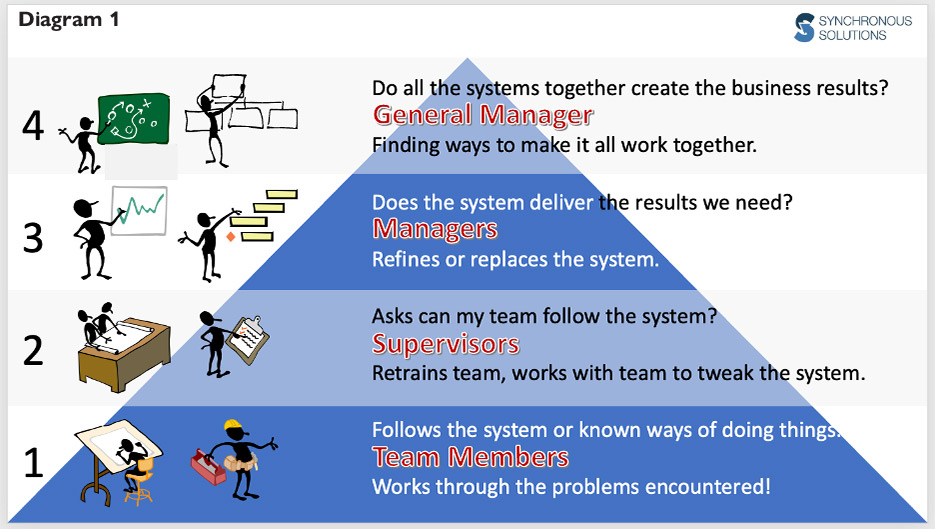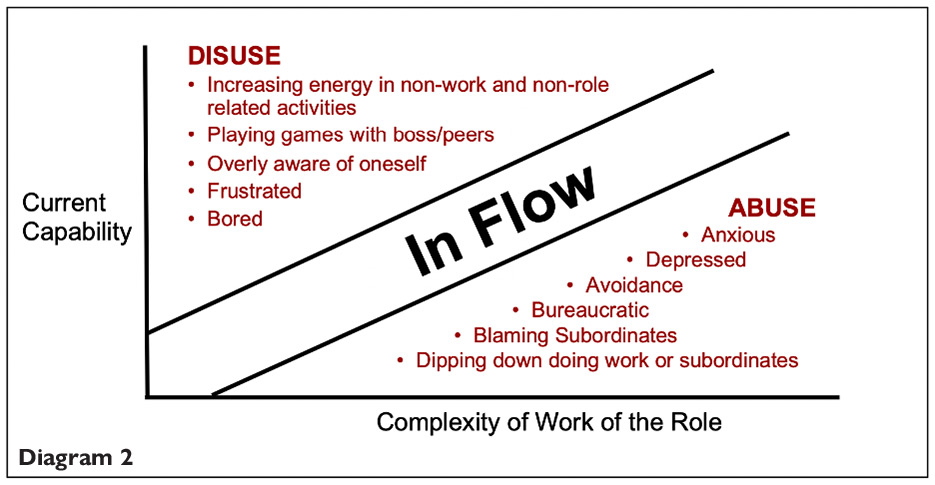Have You Got the Right People in the Right Seats?
Rick Phelps
Synchronous Solutions
Businesses run on systems, and your team runs those systems to deliver consistent results that delight your customer (at least that’s the theory, right?).
What happens when the people responsible for maintaining and improving your systems don’t maintain and improve your systems?
• Your customers’ experiences are inconsistent,
• Problems repeat,
• Chaos creeps in,
• People get frustrated and leave.
Who is responsible for maintaining and improving your systems? If you find yourself pondering this question, allow me to help!
For as long as there have been businesses, businesses have been organizing themselves using a hierarchical structure. Despite this long history, few seem to understand the need for each level of the organization to do different work and solve very different problems. This lack of understanding often results in getting the wrong person into a key role. In fact, it happens so often, it has a name:
The Peter Principal
“In a hierarchy, every employee tends to rise to his level of incompetence.”
“In time, every post tends to be occupied by an employee who is incompetent to carry out its duties. – First Corollary of the Peter Principle
How can you avoid this damaging situation in YOUR business?
Start by understanding the different skills required as people ‘climb the ladder’ in your business and make sure they have demonstrated those specific skills before you promote them!

Diagram 1 above shows the four levels of hierarchy required in a typical fabricating shop doing at least $10M in revenue. If your shop is smaller, you cannot afford all four levels, but you still must ensure that all four levels of work are being completed.
At the base of every business are the team members who make the business run. Great team members follow the procedures and practices of your business, work though the problems as they encounter them, and help improve those processes when asked.
The second level of the hierarchy is typically the supervisor whose role is critical in making sure the team members have everything they need to succeed. This includes processes and procedures that make sense and incorporate the latest best practices that the team has developed.
The third level of hierarchy is department managers. It is at this the level where the problems start when you don’t have the right people in the right seats. This is the first point in someone’s career where they move beyond the direct connection to the ‘work’ of the business, and into the realm of managing managers. Interestingly, this is also the first place one encounters direct accountability for results that come from those business systems. Up to now, accountability has been about the completion of one’s tasks and projects, or one’s team’s completion of tasks or projects, all executed WITHIN the boundaries of the business’ systems.
When you promote a long-time employee who was great at their job executing as a team member, you run the risk of promoting someone whose problem-solving skills don’t match the problem-solving skills required of a manager. When there is a mismatch, they will default to helping ‘on the floor’ and not pay the necessary attention to the systems of their department. This results in the deterioration of the department’s systems, followed by the deterioration of the department’s results.
Suppose your operations manager, who we’ll call Peter, was great when he was the shop leadman, but now that he is the manager, is struggling. Peter was used to working with his hands and creating things. It’s his passion. Making sure the department’s systems are usable, used, and delivering the necessary results is simply NOT where his head is at.
As a result, the rigor associated with the key systems of operations begin to decline. Preventive maintenance on equipment slips. Down time starts creeping up. Shop organization slides as well. As discipline as a whole deteriorates, you lose a key person, frustrated with the declining level of professionalism in the shop.
Call backs go up. Reworks go up. Peter is getting stressed out as the pressure mounts on him to “fix things” he doesn’t know how to fix. Peter is not happy. It’s not just Peter’s fault. You promoted him to his level of incompetence by promoting him away from the work he loved and was capable of doing.
How do you avoid the Peter Principle? You give Peter a special project to do before his promotion, like redesigning the preventive maintenance system or creating a better way to organize flow through the shop. Any project that requires he develop a system to improve the business. If he is a prospect for department manager, he will thrive with this project. If not, you will both know it’s not the right move!

People are most productive and happy when working at the level in the organization that matches their capabilities and interests. It’s called ‘being in flow’ and is shown as the band in the middle of Diagram 2, above where people’s capability matches the complexity of the work they are expected to do. People who have been promoted beyond their capabilities are in the lower part of the chart labeled “Abuse,” a damaging place to be for both the individual and those around them.
People working in roles that under-utilize them are above the flow band, in the realm of “Disuse.” Look at the description of the characteristics of these people, then look at your work force. Some of these “bad apples” may actually be future managers bored out of their minds! I worked with one such “problem employee” at a mining company. That individual became the driving force behind our change initiative that dramatically improved the company. In a few short years he went from problem maintenance planner to the General Manager of a 500-person mine.
We love to help companies thrive. If you need help getting the Right People into the Right Seats, doing the Right Work at the Right Time, give us a call! We would love to help!
If you think having a skilled facilitator to walk your leadership team through this process will make it go a lot more smoothly and efficiently, contact Synchronous Solutions though our website www.synchronoussolutions.com/contact-us/